The Importance of Communication in Business
VerifiedAdded on 2020/07/22
|11
|3121
|41
AI Summary
The provided report emphasizes that communication is a crucial tool for businesses to achieve sustainability. It is essential for both internal and external business success. The document describes various models for improving communication, including visualization in the communication of business strategies. It also highlights the importance of verbal communication in business and how it creates an image of professionalism in the workplace.
Contribute Materials
Your contribution can guide someone’s learning journey. Share your
documents today.
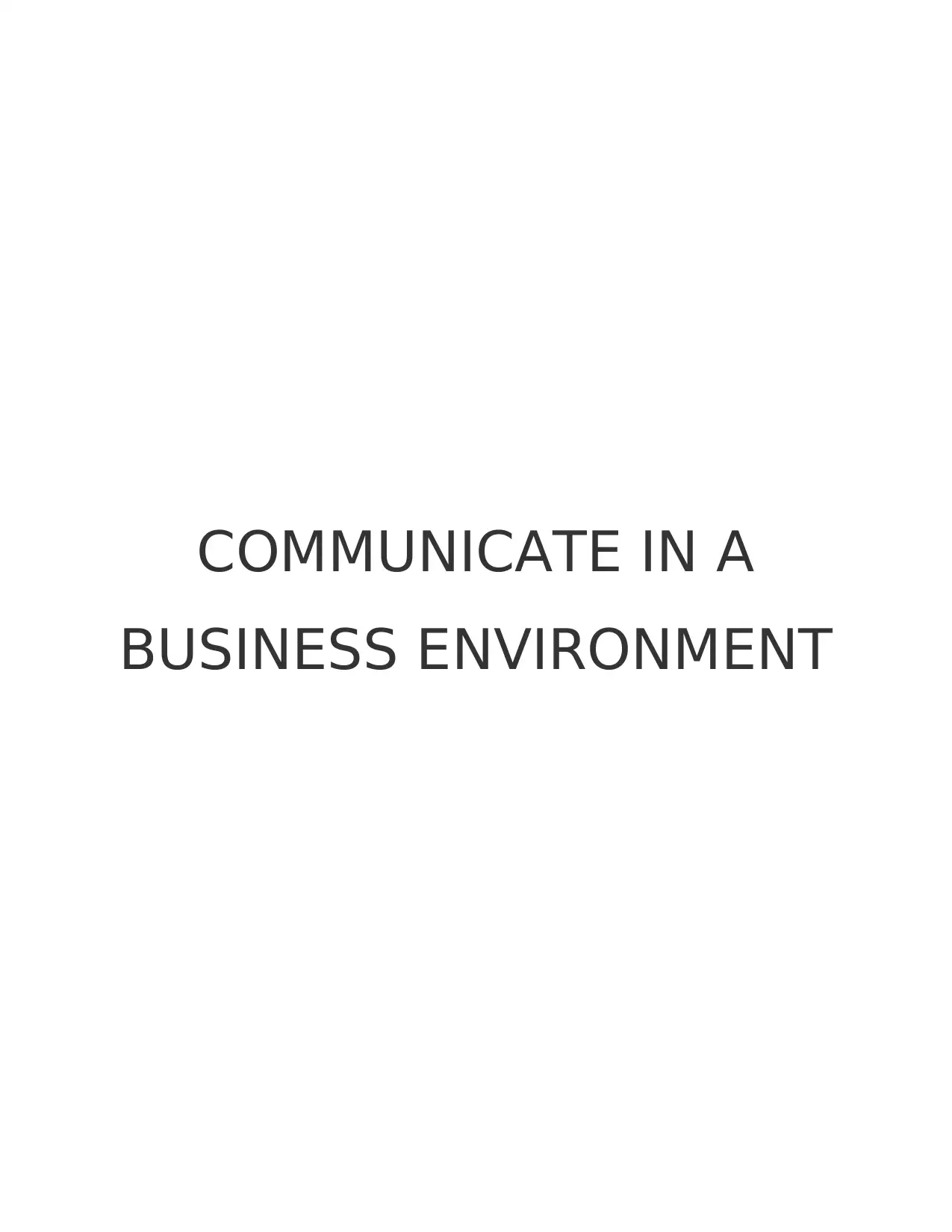
COMMUNICATE IN A
BUSINESS ENVIRONMENT
BUSINESS ENVIRONMENT
Secure Best Marks with AI Grader
Need help grading? Try our AI Grader for instant feedback on your assignments.
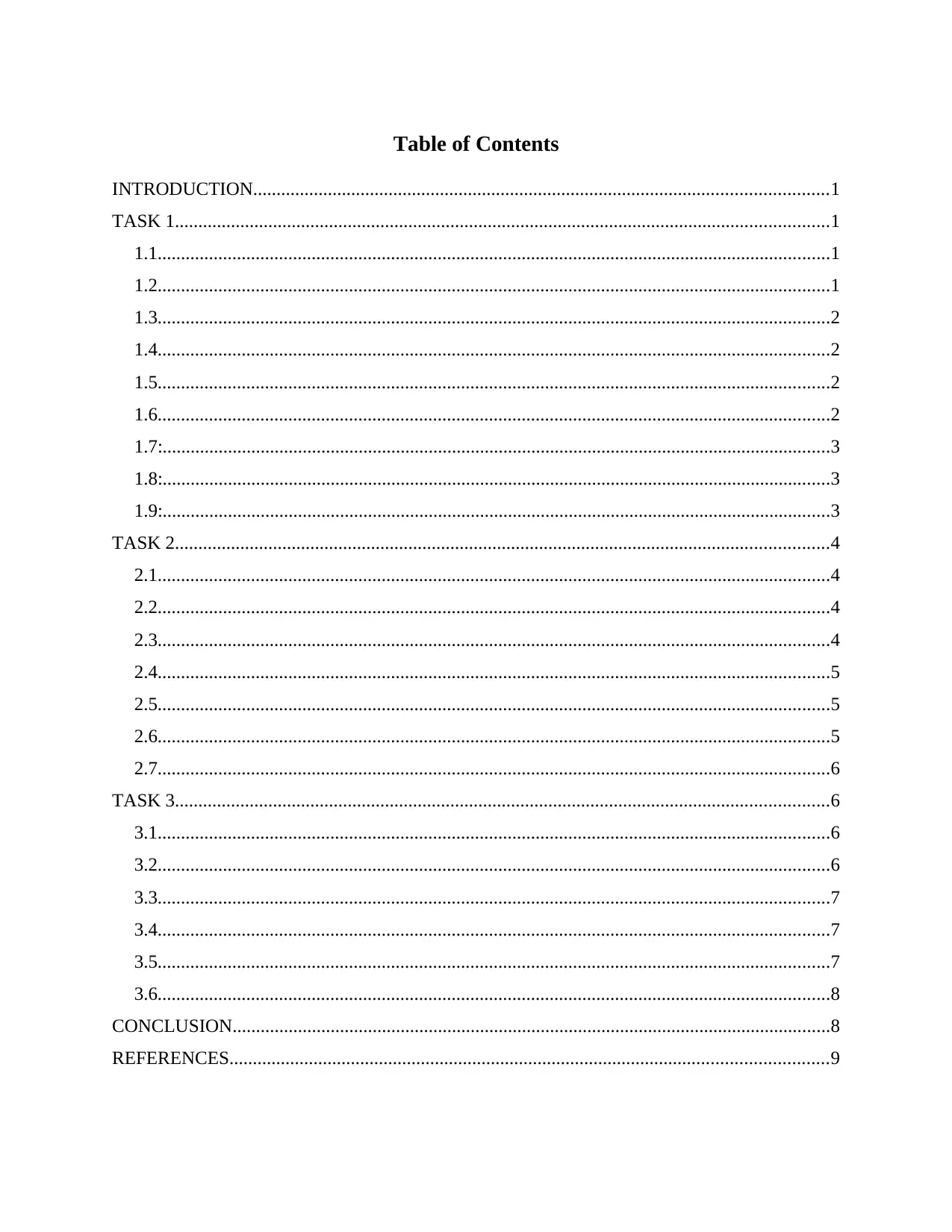
Table of Contents
INTRODUCTION...........................................................................................................................1
TASK 1............................................................................................................................................1
1.1................................................................................................................................................1
1.2................................................................................................................................................1
1.3................................................................................................................................................2
1.4................................................................................................................................................2
1.5................................................................................................................................................2
1.6................................................................................................................................................2
1.7:...............................................................................................................................................3
1.8:...............................................................................................................................................3
1.9:...............................................................................................................................................3
TASK 2............................................................................................................................................4
2.1................................................................................................................................................4
2.2................................................................................................................................................4
2.3................................................................................................................................................4
2.4................................................................................................................................................5
2.5................................................................................................................................................5
2.6................................................................................................................................................5
2.7................................................................................................................................................6
TASK 3............................................................................................................................................6
3.1................................................................................................................................................6
3.2................................................................................................................................................6
3.3................................................................................................................................................7
3.4................................................................................................................................................7
3.5................................................................................................................................................7
3.6................................................................................................................................................8
CONCLUSION................................................................................................................................8
REFERENCES................................................................................................................................9
INTRODUCTION...........................................................................................................................1
TASK 1............................................................................................................................................1
1.1................................................................................................................................................1
1.2................................................................................................................................................1
1.3................................................................................................................................................2
1.4................................................................................................................................................2
1.5................................................................................................................................................2
1.6................................................................................................................................................2
1.7:...............................................................................................................................................3
1.8:...............................................................................................................................................3
1.9:...............................................................................................................................................3
TASK 2............................................................................................................................................4
2.1................................................................................................................................................4
2.2................................................................................................................................................4
2.3................................................................................................................................................4
2.4................................................................................................................................................5
2.5................................................................................................................................................5
2.6................................................................................................................................................5
2.7................................................................................................................................................6
TASK 3............................................................................................................................................6
3.1................................................................................................................................................6
3.2................................................................................................................................................6
3.3................................................................................................................................................7
3.4................................................................................................................................................7
3.5................................................................................................................................................7
3.6................................................................................................................................................8
CONCLUSION................................................................................................................................8
REFERENCES................................................................................................................................9
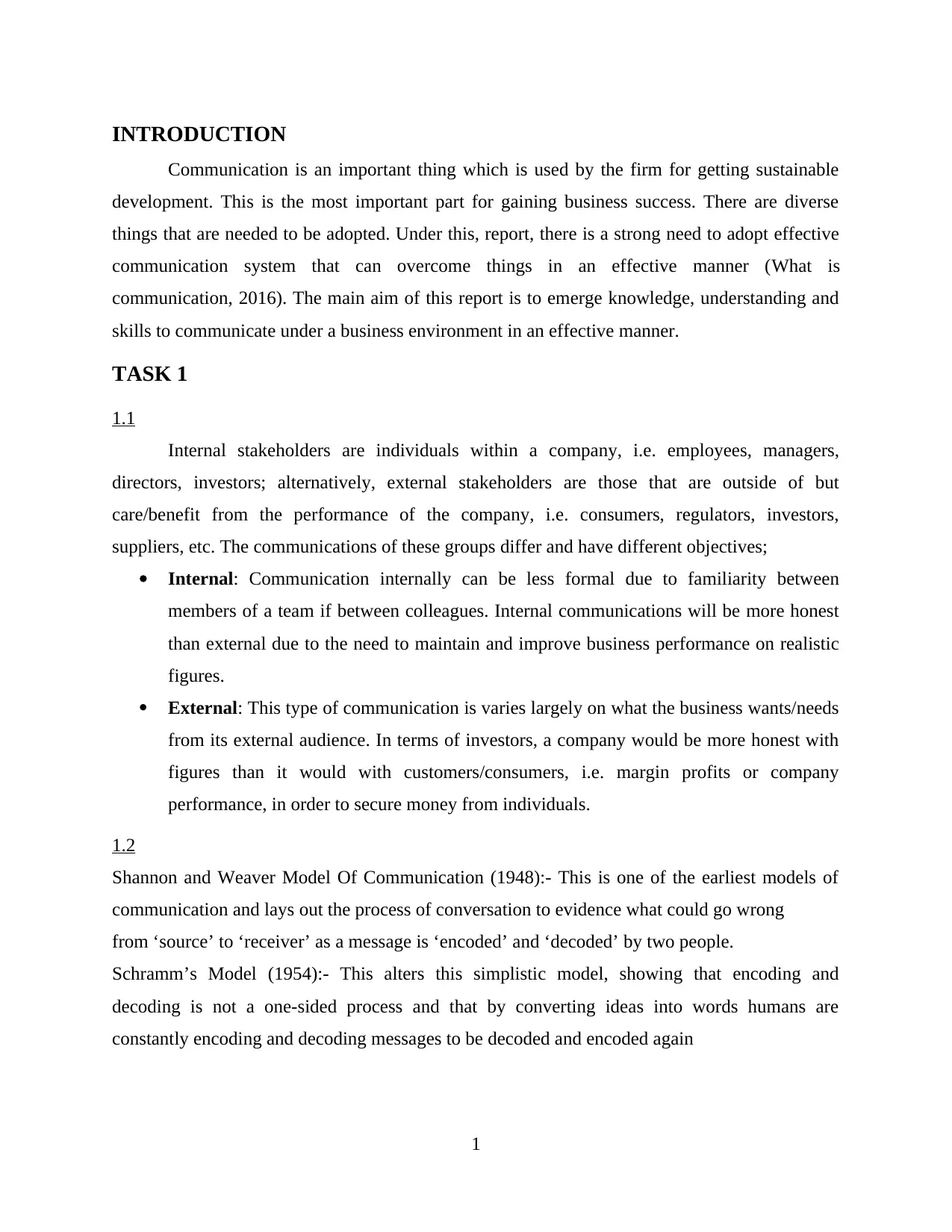
INTRODUCTION
Communication is an important thing which is used by the firm for getting sustainable
development. This is the most important part for gaining business success. There are diverse
things that are needed to be adopted. Under this, report, there is a strong need to adopt effective
communication system that can overcome things in an effective manner (What is
communication, 2016). The main aim of this report is to emerge knowledge, understanding and
skills to communicate under a business environment in an effective manner.
TASK 1
1.1
Internal stakeholders are individuals within a company, i.e. employees, managers,
directors, investors; alternatively, external stakeholders are those that are outside of but
care/benefit from the performance of the company, i.e. consumers, regulators, investors,
suppliers, etc. The communications of these groups differ and have different objectives;
Internal: Communication internally can be less formal due to familiarity between
members of a team if between colleagues. Internal communications will be more honest
than external due to the need to maintain and improve business performance on realistic
figures.
External: This type of communication is varies largely on what the business wants/needs
from its external audience. In terms of investors, a company would be more honest with
figures than it would with customers/consumers, i.e. margin profits or company
performance, in order to secure money from individuals.
1.2
Shannon and Weaver Model Of Communication (1948):- This is one of the earliest models of
communication and lays out the process of conversation to evidence what could go wrong
from ‘source’ to ‘receiver’ as a message is ‘encoded’ and ‘decoded’ by two people.
Schramm’s Model (1954):- This alters this simplistic model, showing that encoding and
decoding is not a one-sided process and that by converting ideas into words humans are
constantly encoding and decoding messages to be decoded and encoded again
1
Communication is an important thing which is used by the firm for getting sustainable
development. This is the most important part for gaining business success. There are diverse
things that are needed to be adopted. Under this, report, there is a strong need to adopt effective
communication system that can overcome things in an effective manner (What is
communication, 2016). The main aim of this report is to emerge knowledge, understanding and
skills to communicate under a business environment in an effective manner.
TASK 1
1.1
Internal stakeholders are individuals within a company, i.e. employees, managers,
directors, investors; alternatively, external stakeholders are those that are outside of but
care/benefit from the performance of the company, i.e. consumers, regulators, investors,
suppliers, etc. The communications of these groups differ and have different objectives;
Internal: Communication internally can be less formal due to familiarity between
members of a team if between colleagues. Internal communications will be more honest
than external due to the need to maintain and improve business performance on realistic
figures.
External: This type of communication is varies largely on what the business wants/needs
from its external audience. In terms of investors, a company would be more honest with
figures than it would with customers/consumers, i.e. margin profits or company
performance, in order to secure money from individuals.
1.2
Shannon and Weaver Model Of Communication (1948):- This is one of the earliest models of
communication and lays out the process of conversation to evidence what could go wrong
from ‘source’ to ‘receiver’ as a message is ‘encoded’ and ‘decoded’ by two people.
Schramm’s Model (1954):- This alters this simplistic model, showing that encoding and
decoding is not a one-sided process and that by converting ideas into words humans are
constantly encoding and decoding messages to be decoded and encoded again
1
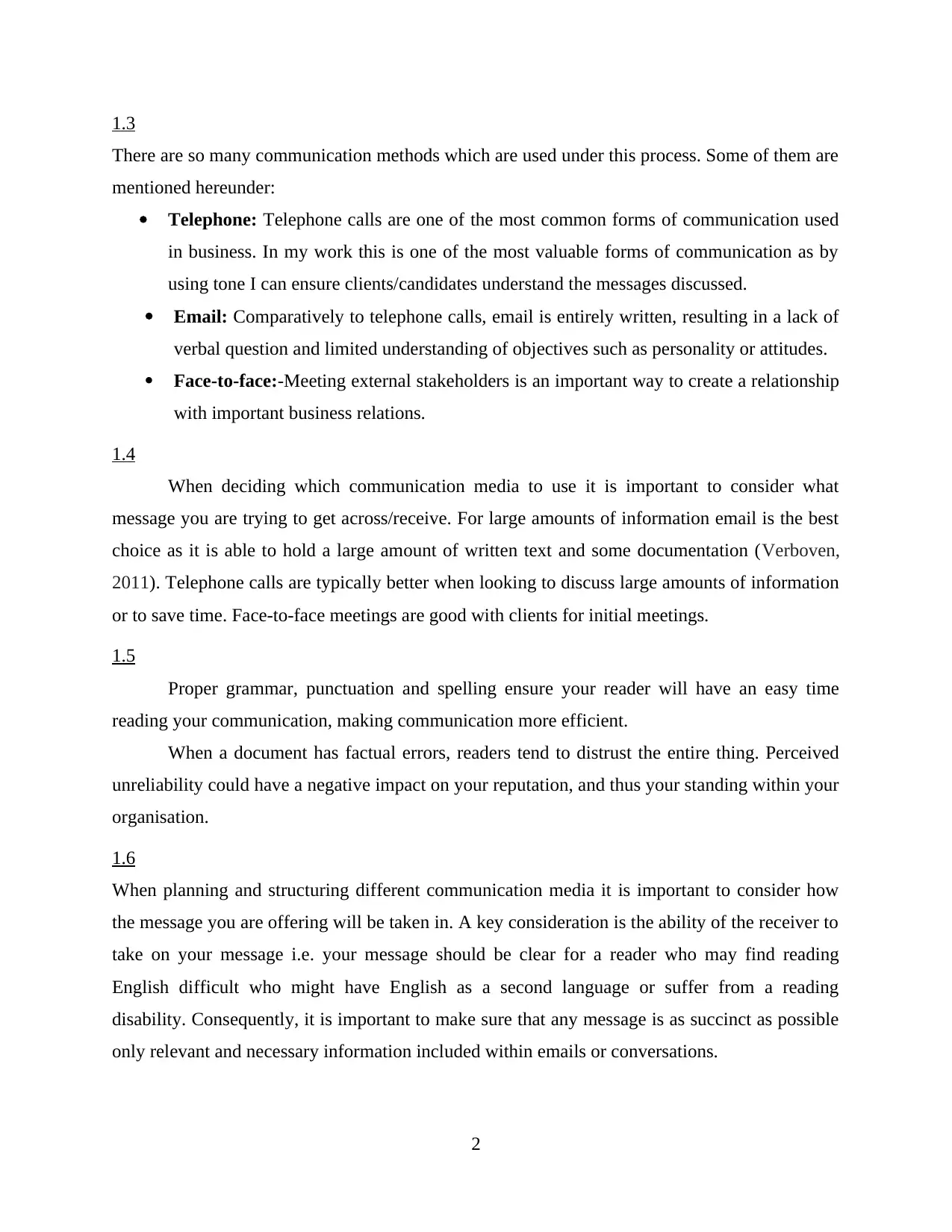
1.3
There are so many communication methods which are used under this process. Some of them are
mentioned hereunder:
Telephone: Telephone calls are one of the most common forms of communication used
in business. In my work this is one of the most valuable forms of communication as by
using tone I can ensure clients/candidates understand the messages discussed.
Email: Comparatively to telephone calls, email is entirely written, resulting in a lack of
verbal question and limited understanding of objectives such as personality or attitudes.
Face-to-face:-Meeting external stakeholders is an important way to create a relationship
with important business relations.
1.4
When deciding which communication media to use it is important to consider what
message you are trying to get across/receive. For large amounts of information email is the best
choice as it is able to hold a large amount of written text and some documentation (Verboven,
2011). Telephone calls are typically better when looking to discuss large amounts of information
or to save time. Face-to-face meetings are good with clients for initial meetings.
1.5
Proper grammar, punctuation and spelling ensure your reader will have an easy time
reading your communication, making communication more efficient.
When a document has factual errors, readers tend to distrust the entire thing. Perceived
unreliability could have a negative impact on your reputation, and thus your standing within your
organisation.
1.6
When planning and structuring different communication media it is important to consider how
the message you are offering will be taken in. A key consideration is the ability of the receiver to
take on your message i.e. your message should be clear for a reader who may find reading
English difficult who might have English as a second language or suffer from a reading
disability. Consequently, it is important to make sure that any message is as succinct as possible
only relevant and necessary information included within emails or conversations.
2
There are so many communication methods which are used under this process. Some of them are
mentioned hereunder:
Telephone: Telephone calls are one of the most common forms of communication used
in business. In my work this is one of the most valuable forms of communication as by
using tone I can ensure clients/candidates understand the messages discussed.
Email: Comparatively to telephone calls, email is entirely written, resulting in a lack of
verbal question and limited understanding of objectives such as personality or attitudes.
Face-to-face:-Meeting external stakeholders is an important way to create a relationship
with important business relations.
1.4
When deciding which communication media to use it is important to consider what
message you are trying to get across/receive. For large amounts of information email is the best
choice as it is able to hold a large amount of written text and some documentation (Verboven,
2011). Telephone calls are typically better when looking to discuss large amounts of information
or to save time. Face-to-face meetings are good with clients for initial meetings.
1.5
Proper grammar, punctuation and spelling ensure your reader will have an easy time
reading your communication, making communication more efficient.
When a document has factual errors, readers tend to distrust the entire thing. Perceived
unreliability could have a negative impact on your reputation, and thus your standing within your
organisation.
1.6
When planning and structuring different communication media it is important to consider how
the message you are offering will be taken in. A key consideration is the ability of the receiver to
take on your message i.e. your message should be clear for a reader who may find reading
English difficult who might have English as a second language or suffer from a reading
disability. Consequently, it is important to make sure that any message is as succinct as possible
only relevant and necessary information included within emails or conversations.
2
Secure Best Marks with AI Grader
Need help grading? Try our AI Grader for instant feedback on your assignments.
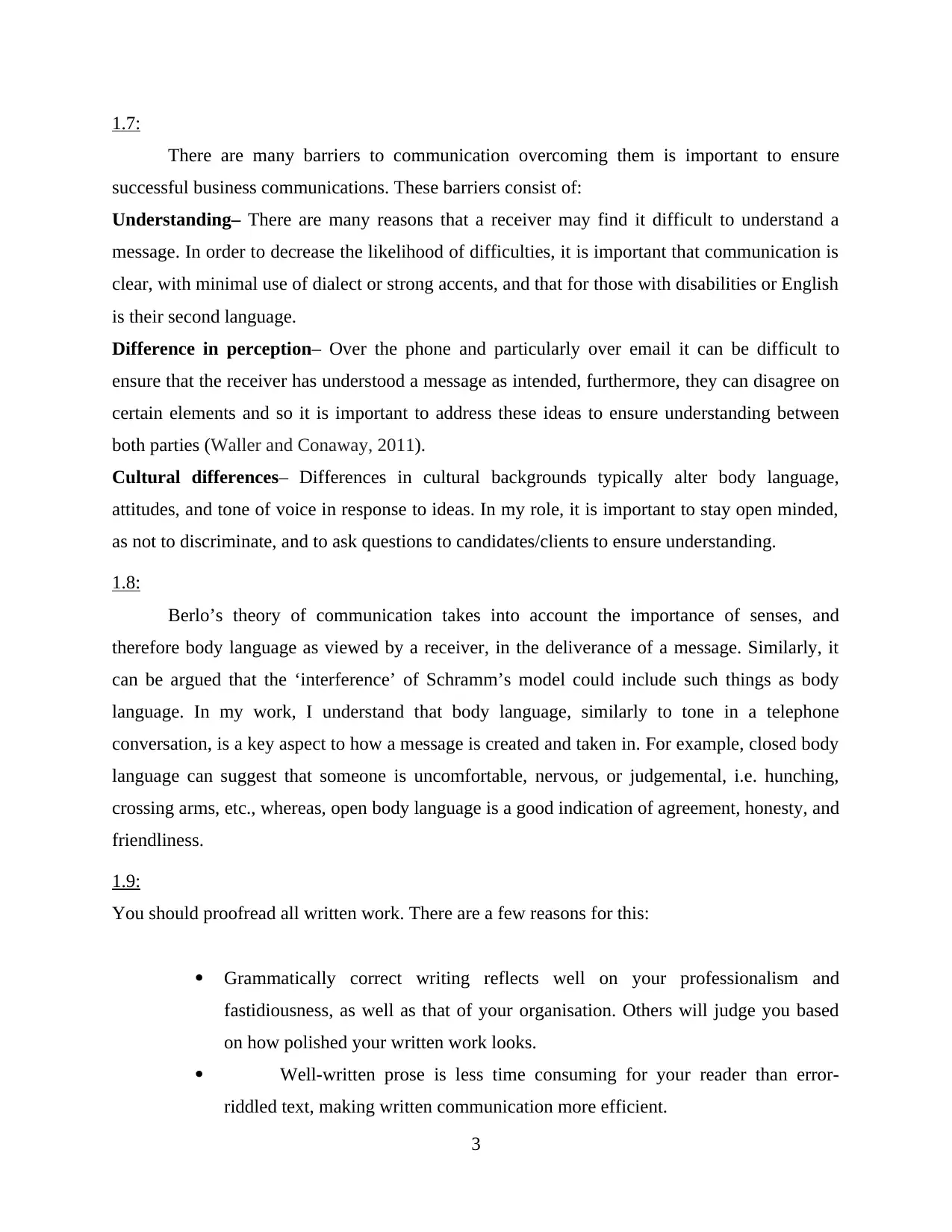
1.7:
There are many barriers to communication overcoming them is important to ensure
successful business communications. These barriers consist of:
Understanding– There are many reasons that a receiver may find it difficult to understand a
message. In order to decrease the likelihood of difficulties, it is important that communication is
clear, with minimal use of dialect or strong accents, and that for those with disabilities or English
is their second language.
Difference in perception– Over the phone and particularly over email it can be difficult to
ensure that the receiver has understood a message as intended, furthermore, they can disagree on
certain elements and so it is important to address these ideas to ensure understanding between
both parties (Waller and Conaway, 2011).
Cultural differences– Differences in cultural backgrounds typically alter body language,
attitudes, and tone of voice in response to ideas. In my role, it is important to stay open minded,
as not to discriminate, and to ask questions to candidates/clients to ensure understanding.
1.8:
Berlo’s theory of communication takes into account the importance of senses, and
therefore body language as viewed by a receiver, in the deliverance of a message. Similarly, it
can be argued that the ‘interference’ of Schramm’s model could include such things as body
language. In my work, I understand that body language, similarly to tone in a telephone
conversation, is a key aspect to how a message is created and taken in. For example, closed body
language can suggest that someone is uncomfortable, nervous, or judgemental, i.e. hunching,
crossing arms, etc., whereas, open body language is a good indication of agreement, honesty, and
friendliness.
1.9:
You should proofread all written work. There are a few reasons for this:
Grammatically correct writing reflects well on your professionalism and
fastidiousness, as well as that of your organisation. Others will judge you based
on how polished your written work looks.
Well-written prose is less time consuming for your reader than error-
riddled text, making written communication more efficient.
3
There are many barriers to communication overcoming them is important to ensure
successful business communications. These barriers consist of:
Understanding– There are many reasons that a receiver may find it difficult to understand a
message. In order to decrease the likelihood of difficulties, it is important that communication is
clear, with minimal use of dialect or strong accents, and that for those with disabilities or English
is their second language.
Difference in perception– Over the phone and particularly over email it can be difficult to
ensure that the receiver has understood a message as intended, furthermore, they can disagree on
certain elements and so it is important to address these ideas to ensure understanding between
both parties (Waller and Conaway, 2011).
Cultural differences– Differences in cultural backgrounds typically alter body language,
attitudes, and tone of voice in response to ideas. In my role, it is important to stay open minded,
as not to discriminate, and to ask questions to candidates/clients to ensure understanding.
1.8:
Berlo’s theory of communication takes into account the importance of senses, and
therefore body language as viewed by a receiver, in the deliverance of a message. Similarly, it
can be argued that the ‘interference’ of Schramm’s model could include such things as body
language. In my work, I understand that body language, similarly to tone in a telephone
conversation, is a key aspect to how a message is created and taken in. For example, closed body
language can suggest that someone is uncomfortable, nervous, or judgemental, i.e. hunching,
crossing arms, etc., whereas, open body language is a good indication of agreement, honesty, and
friendliness.
1.9:
You should proofread all written work. There are a few reasons for this:
Grammatically correct writing reflects well on your professionalism and
fastidiousness, as well as that of your organisation. Others will judge you based
on how polished your written work looks.
Well-written prose is less time consuming for your reader than error-
riddled text, making written communication more efficient.
3
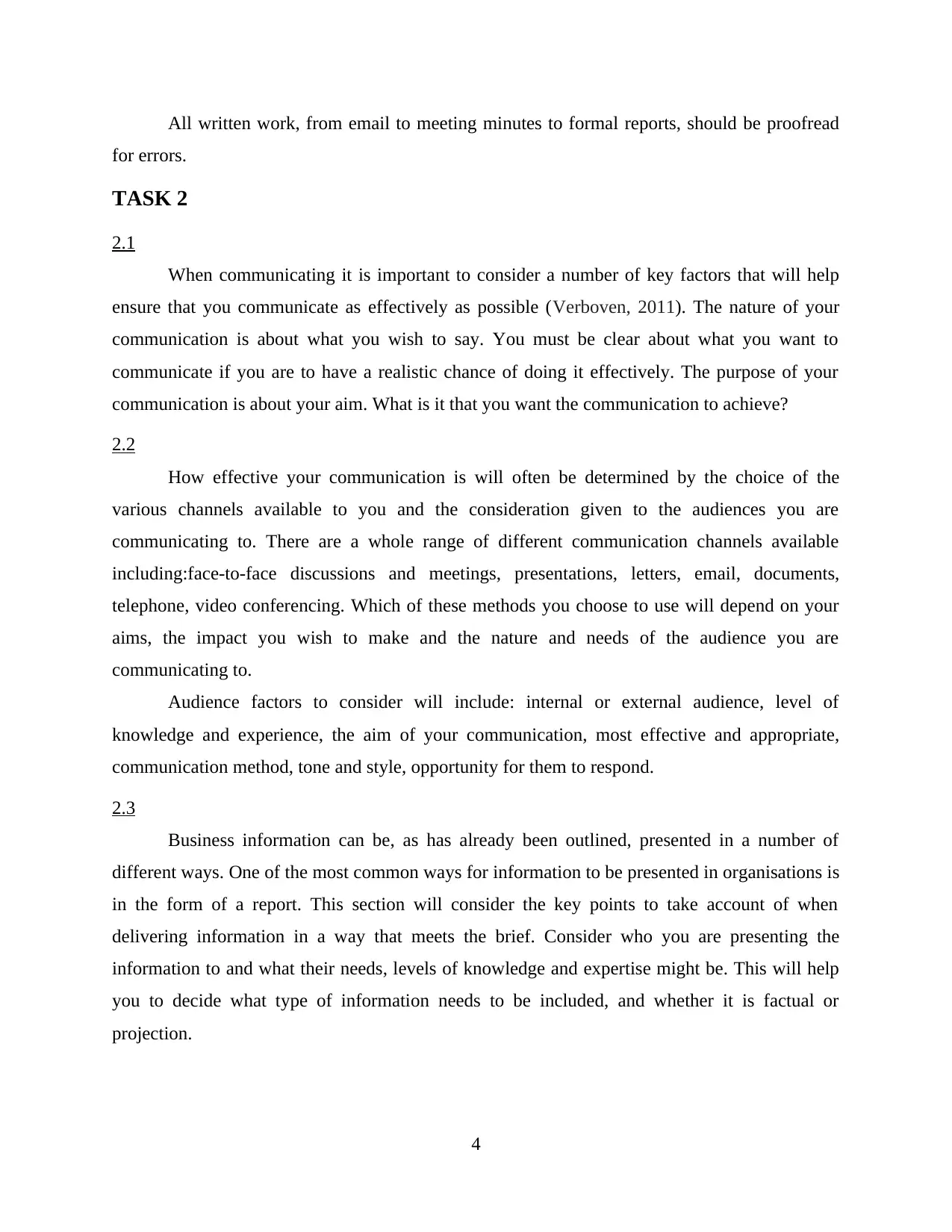
All written work, from email to meeting minutes to formal reports, should be proofread
for errors.
TASK 2
2.1
When communicating it is important to consider a number of key factors that will help
ensure that you communicate as effectively as possible (Verboven, 2011). The nature of your
communication is about what you wish to say. You must be clear about what you want to
communicate if you are to have a realistic chance of doing it effectively. The purpose of your
communication is about your aim. What is it that you want the communication to achieve?
2.2
How effective your communication is will often be determined by the choice of the
various channels available to you and the consideration given to the audiences you are
communicating to. There are a whole range of different communication channels available
including:face-to-face discussions and meetings, presentations, letters, email, documents,
telephone, video conferencing. Which of these methods you choose to use will depend on your
aims, the impact you wish to make and the nature and needs of the audience you are
communicating to.
Audience factors to consider will include: internal or external audience, level of
knowledge and experience, the aim of your communication, most effective and appropriate,
communication method, tone and style, opportunity for them to respond.
2.3
Business information can be, as has already been outlined, presented in a number of
different ways. One of the most common ways for information to be presented in organisations is
in the form of a report. This section will consider the key points to take account of when
delivering information in a way that meets the brief. Consider who you are presenting the
information to and what their needs, levels of knowledge and expertise might be. This will help
you to decide what type of information needs to be included, and whether it is factual or
projection.
4
for errors.
TASK 2
2.1
When communicating it is important to consider a number of key factors that will help
ensure that you communicate as effectively as possible (Verboven, 2011). The nature of your
communication is about what you wish to say. You must be clear about what you want to
communicate if you are to have a realistic chance of doing it effectively. The purpose of your
communication is about your aim. What is it that you want the communication to achieve?
2.2
How effective your communication is will often be determined by the choice of the
various channels available to you and the consideration given to the audiences you are
communicating to. There are a whole range of different communication channels available
including:face-to-face discussions and meetings, presentations, letters, email, documents,
telephone, video conferencing. Which of these methods you choose to use will depend on your
aims, the impact you wish to make and the nature and needs of the audience you are
communicating to.
Audience factors to consider will include: internal or external audience, level of
knowledge and experience, the aim of your communication, most effective and appropriate,
communication method, tone and style, opportunity for them to respond.
2.3
Business information can be, as has already been outlined, presented in a number of
different ways. One of the most common ways for information to be presented in organisations is
in the form of a report. This section will consider the key points to take account of when
delivering information in a way that meets the brief. Consider who you are presenting the
information to and what their needs, levels of knowledge and expertise might be. This will help
you to decide what type of information needs to be included, and whether it is factual or
projection.
4
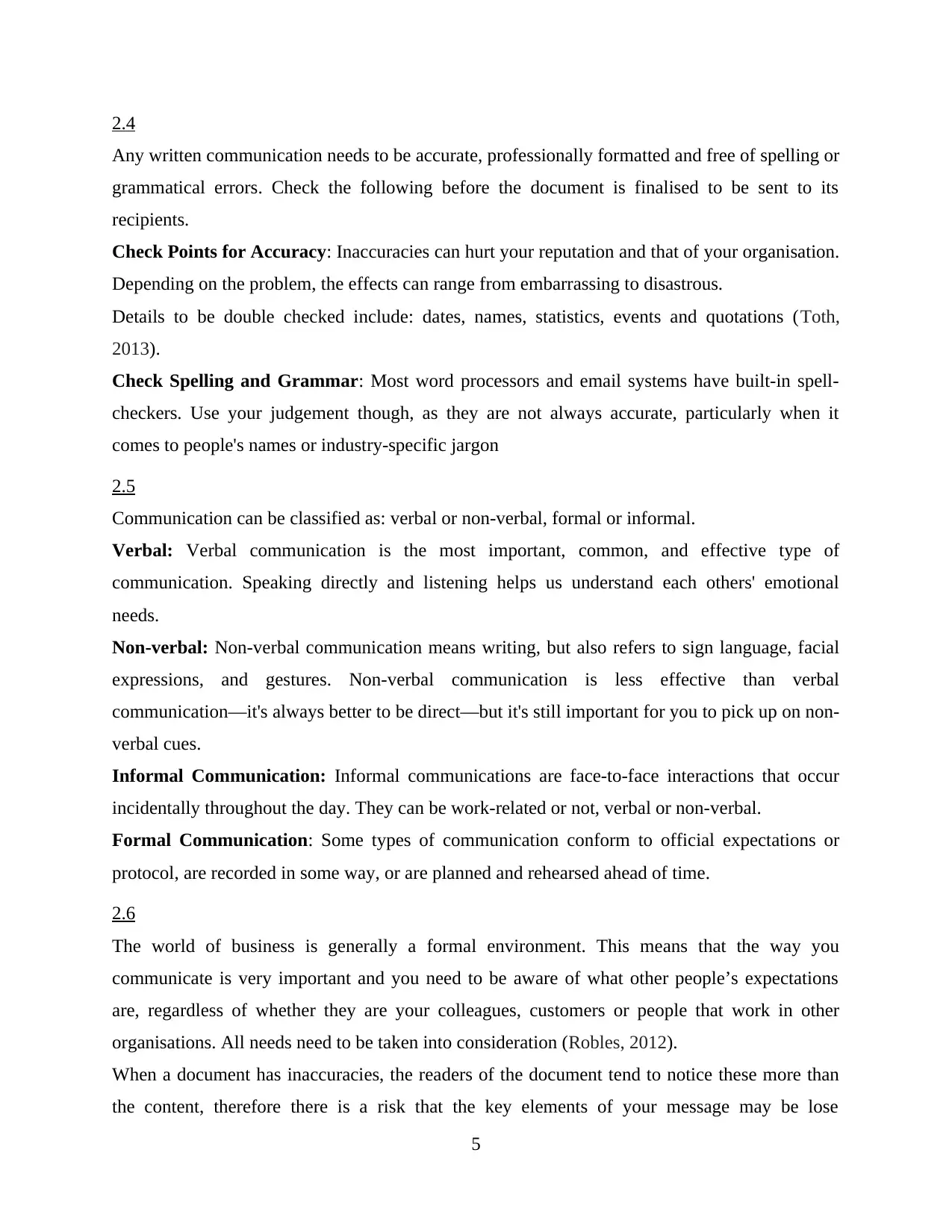
2.4
Any written communication needs to be accurate, professionally formatted and free of spelling or
grammatical errors. Check the following before the document is finalised to be sent to its
recipients.
Check Points for Accuracy: Inaccuracies can hurt your reputation and that of your organisation.
Depending on the problem, the effects can range from embarrassing to disastrous.
Details to be double checked include: dates, names, statistics, events and quotations (Toth,
2013).
Check Spelling and Grammar: Most word processors and email systems have built-in spell-
checkers. Use your judgement though, as they are not always accurate, particularly when it
comes to people's names or industry-specific jargon
2.5
Communication can be classified as: verbal or non-verbal, formal or informal.
Verbal: Verbal communication is the most important, common, and effective type of
communication. Speaking directly and listening helps us understand each others' emotional
needs.
Non-verbal: Non-verbal communication means writing, but also refers to sign language, facial
expressions, and gestures. Non-verbal communication is less effective than verbal
communication—it's always better to be direct—but it's still important for you to pick up on non-
verbal cues.
Informal Communication: Informal communications are face-to-face interactions that occur
incidentally throughout the day. They can be work-related or not, verbal or non-verbal.
Formal Communication: Some types of communication conform to official expectations or
protocol, are recorded in some way, or are planned and rehearsed ahead of time.
2.6
The world of business is generally a formal environment. This means that the way you
communicate is very important and you need to be aware of what other people’s expectations
are, regardless of whether they are your colleagues, customers or people that work in other
organisations. All needs need to be taken into consideration (Robles, 2012).
When a document has inaccuracies, the readers of the document tend to notice these more than
the content, therefore there is a risk that the key elements of your message may be lose
5
Any written communication needs to be accurate, professionally formatted and free of spelling or
grammatical errors. Check the following before the document is finalised to be sent to its
recipients.
Check Points for Accuracy: Inaccuracies can hurt your reputation and that of your organisation.
Depending on the problem, the effects can range from embarrassing to disastrous.
Details to be double checked include: dates, names, statistics, events and quotations (Toth,
2013).
Check Spelling and Grammar: Most word processors and email systems have built-in spell-
checkers. Use your judgement though, as they are not always accurate, particularly when it
comes to people's names or industry-specific jargon
2.5
Communication can be classified as: verbal or non-verbal, formal or informal.
Verbal: Verbal communication is the most important, common, and effective type of
communication. Speaking directly and listening helps us understand each others' emotional
needs.
Non-verbal: Non-verbal communication means writing, but also refers to sign language, facial
expressions, and gestures. Non-verbal communication is less effective than verbal
communication—it's always better to be direct—but it's still important for you to pick up on non-
verbal cues.
Informal Communication: Informal communications are face-to-face interactions that occur
incidentally throughout the day. They can be work-related or not, verbal or non-verbal.
Formal Communication: Some types of communication conform to official expectations or
protocol, are recorded in some way, or are planned and rehearsed ahead of time.
2.6
The world of business is generally a formal environment. This means that the way you
communicate is very important and you need to be aware of what other people’s expectations
are, regardless of whether they are your colleagues, customers or people that work in other
organisations. All needs need to be taken into consideration (Robles, 2012).
When a document has inaccuracies, the readers of the document tend to notice these more than
the content, therefore there is a risk that the key elements of your message may be lose
5
Paraphrase This Document
Need a fresh take? Get an instant paraphrase of this document with our AI Paraphraser
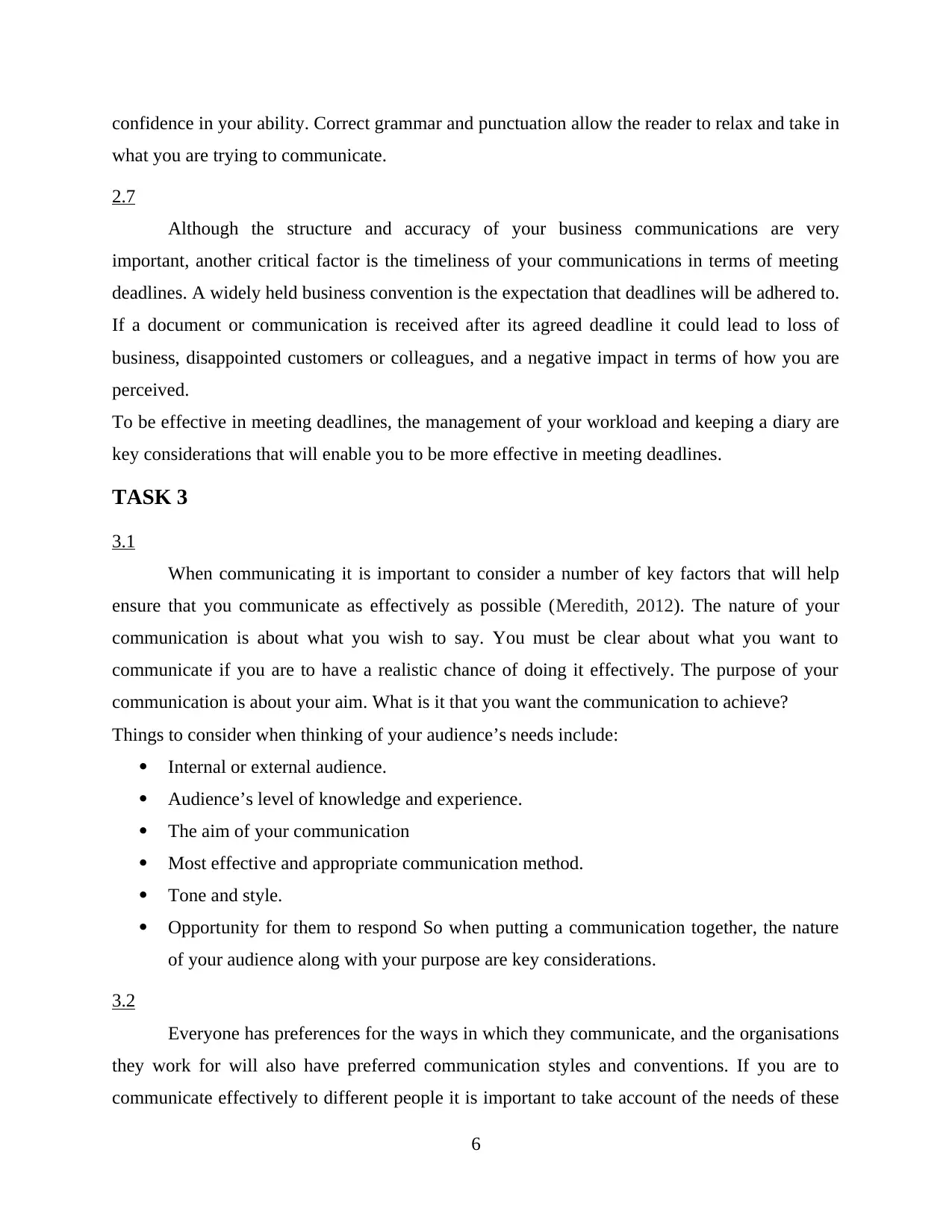
confidence in your ability. Correct grammar and punctuation allow the reader to relax and take in
what you are trying to communicate.
2.7
Although the structure and accuracy of your business communications are very
important, another critical factor is the timeliness of your communications in terms of meeting
deadlines. A widely held business convention is the expectation that deadlines will be adhered to.
If a document or communication is received after its agreed deadline it could lead to loss of
business, disappointed customers or colleagues, and a negative impact in terms of how you are
perceived.
To be effective in meeting deadlines, the management of your workload and keeping a diary are
key considerations that will enable you to be more effective in meeting deadlines.
TASK 3
3.1
When communicating it is important to consider a number of key factors that will help
ensure that you communicate as effectively as possible (Meredith, 2012). The nature of your
communication is about what you wish to say. You must be clear about what you want to
communicate if you are to have a realistic chance of doing it effectively. The purpose of your
communication is about your aim. What is it that you want the communication to achieve?
Things to consider when thinking of your audience’s needs include:
Internal or external audience.
Audience’s level of knowledge and experience.
The aim of your communication
Most effective and appropriate communication method.
Tone and style.
Opportunity for them to respond So when putting a communication together, the nature
of your audience along with your purpose are key considerations.
3.2
Everyone has preferences for the ways in which they communicate, and the organisations
they work for will also have preferred communication styles and conventions. If you are to
communicate effectively to different people it is important to take account of the needs of these
6
what you are trying to communicate.
2.7
Although the structure and accuracy of your business communications are very
important, another critical factor is the timeliness of your communications in terms of meeting
deadlines. A widely held business convention is the expectation that deadlines will be adhered to.
If a document or communication is received after its agreed deadline it could lead to loss of
business, disappointed customers or colleagues, and a negative impact in terms of how you are
perceived.
To be effective in meeting deadlines, the management of your workload and keeping a diary are
key considerations that will enable you to be more effective in meeting deadlines.
TASK 3
3.1
When communicating it is important to consider a number of key factors that will help
ensure that you communicate as effectively as possible (Meredith, 2012). The nature of your
communication is about what you wish to say. You must be clear about what you want to
communicate if you are to have a realistic chance of doing it effectively. The purpose of your
communication is about your aim. What is it that you want the communication to achieve?
Things to consider when thinking of your audience’s needs include:
Internal or external audience.
Audience’s level of knowledge and experience.
The aim of your communication
Most effective and appropriate communication method.
Tone and style.
Opportunity for them to respond So when putting a communication together, the nature
of your audience along with your purpose are key considerations.
3.2
Everyone has preferences for the ways in which they communicate, and the organisations
they work for will also have preferred communication styles and conventions. If you are to
communicate effectively to different people it is important to take account of the needs of these
6
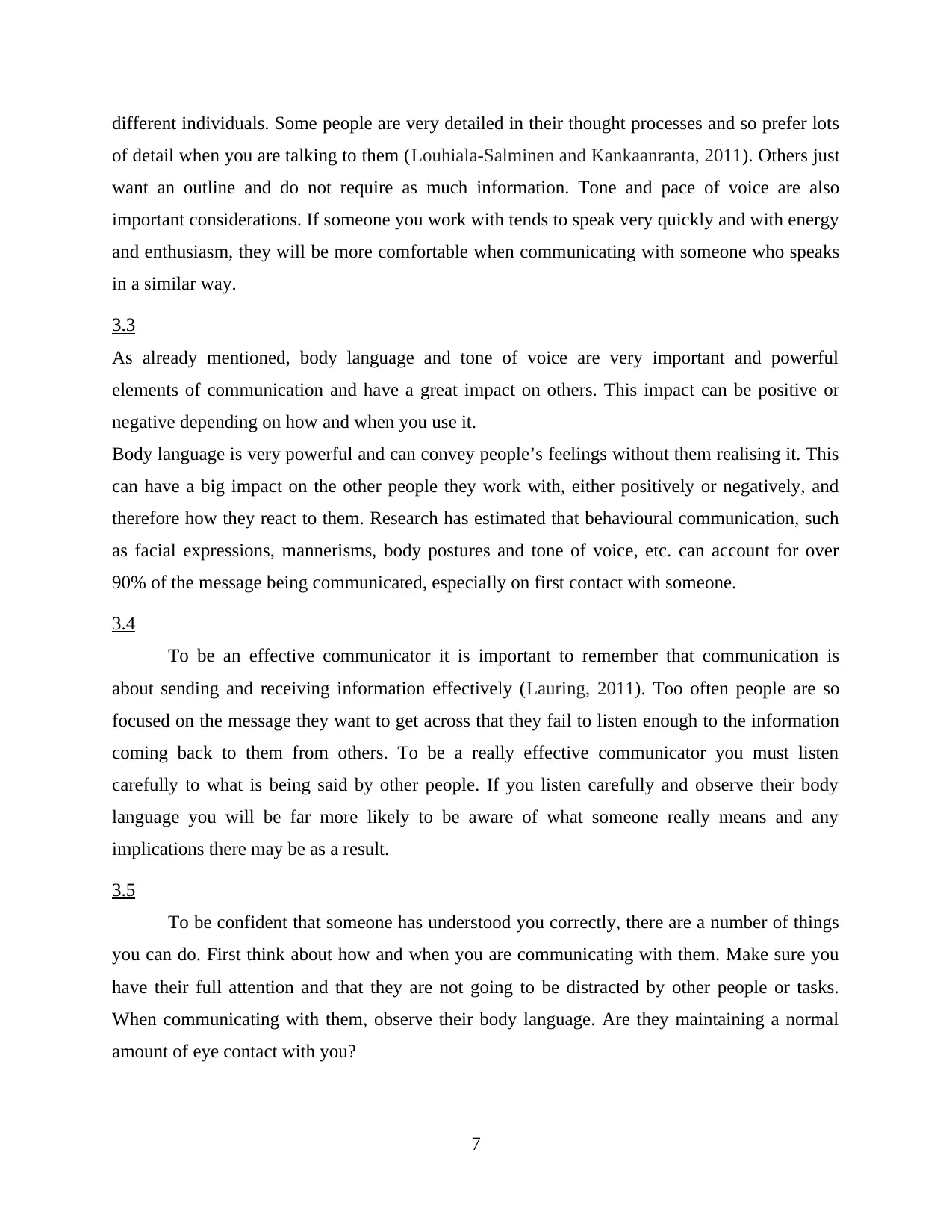
different individuals. Some people are very detailed in their thought processes and so prefer lots
of detail when you are talking to them (Louhiala-Salminen and Kankaanranta, 2011). Others just
want an outline and do not require as much information. Tone and pace of voice are also
important considerations. If someone you work with tends to speak very quickly and with energy
and enthusiasm, they will be more comfortable when communicating with someone who speaks
in a similar way.
3.3
As already mentioned, body language and tone of voice are very important and powerful
elements of communication and have a great impact on others. This impact can be positive or
negative depending on how and when you use it.
Body language is very powerful and can convey people’s feelings without them realising it. This
can have a big impact on the other people they work with, either positively or negatively, and
therefore how they react to them. Research has estimated that behavioural communication, such
as facial expressions, mannerisms, body postures and tone of voice, etc. can account for over
90% of the message being communicated, especially on first contact with someone.
3.4
To be an effective communicator it is important to remember that communication is
about sending and receiving information effectively (Lauring, 2011). Too often people are so
focused on the message they want to get across that they fail to listen enough to the information
coming back to them from others. To be a really effective communicator you must listen
carefully to what is being said by other people. If you listen carefully and observe their body
language you will be far more likely to be aware of what someone really means and any
implications there may be as a result.
3.5
To be confident that someone has understood you correctly, there are a number of things
you can do. First think about how and when you are communicating with them. Make sure you
have their full attention and that they are not going to be distracted by other people or tasks.
When communicating with them, observe their body language. Are they maintaining a normal
amount of eye contact with you?
7
of detail when you are talking to them (Louhiala-Salminen and Kankaanranta, 2011). Others just
want an outline and do not require as much information. Tone and pace of voice are also
important considerations. If someone you work with tends to speak very quickly and with energy
and enthusiasm, they will be more comfortable when communicating with someone who speaks
in a similar way.
3.3
As already mentioned, body language and tone of voice are very important and powerful
elements of communication and have a great impact on others. This impact can be positive or
negative depending on how and when you use it.
Body language is very powerful and can convey people’s feelings without them realising it. This
can have a big impact on the other people they work with, either positively or negatively, and
therefore how they react to them. Research has estimated that behavioural communication, such
as facial expressions, mannerisms, body postures and tone of voice, etc. can account for over
90% of the message being communicated, especially on first contact with someone.
3.4
To be an effective communicator it is important to remember that communication is
about sending and receiving information effectively (Lauring, 2011). Too often people are so
focused on the message they want to get across that they fail to listen enough to the information
coming back to them from others. To be a really effective communicator you must listen
carefully to what is being said by other people. If you listen carefully and observe their body
language you will be far more likely to be aware of what someone really means and any
implications there may be as a result.
3.5
To be confident that someone has understood you correctly, there are a number of things
you can do. First think about how and when you are communicating with them. Make sure you
have their full attention and that they are not going to be distracted by other people or tasks.
When communicating with them, observe their body language. Are they maintaining a normal
amount of eye contact with you?
7
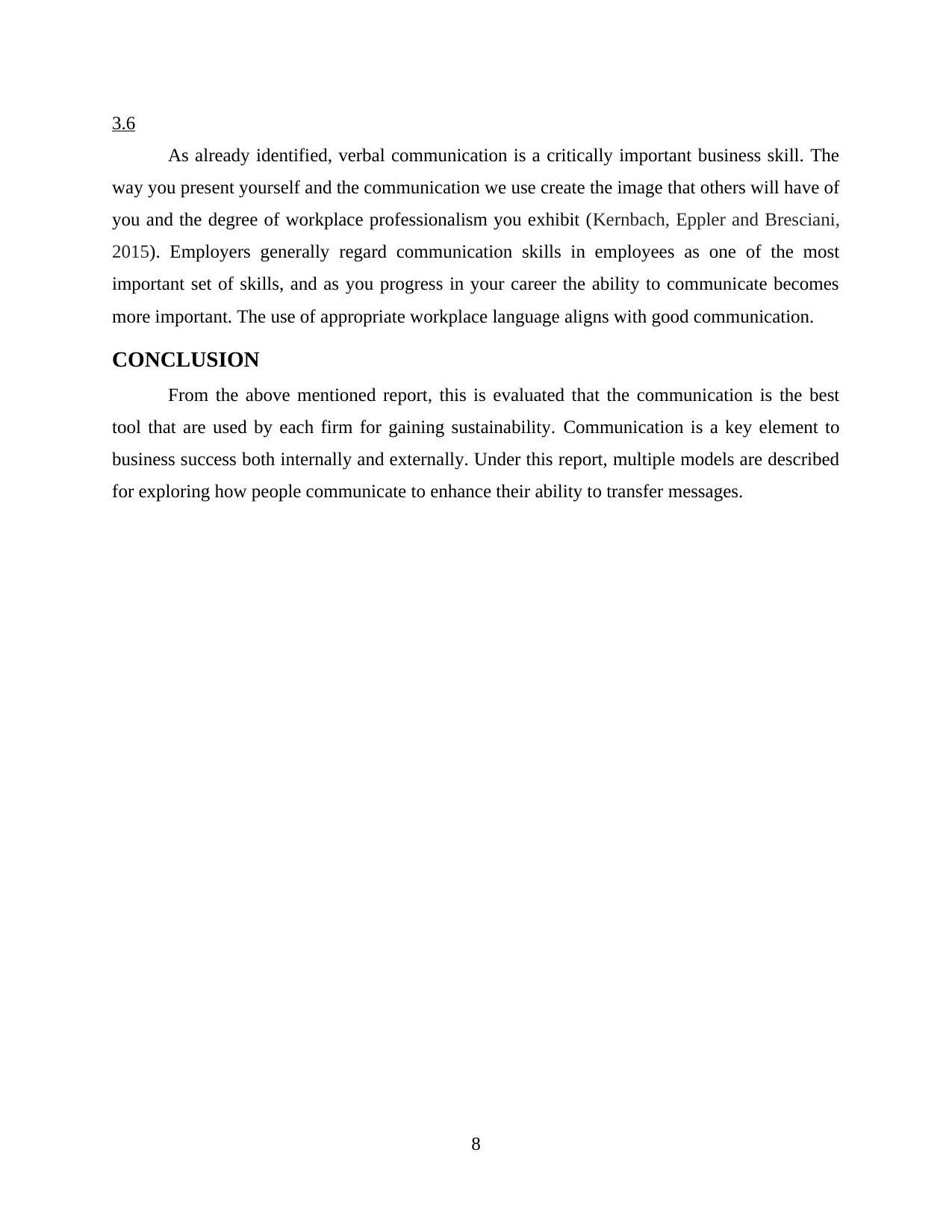
3.6
As already identified, verbal communication is a critically important business skill. The
way you present yourself and the communication we use create the image that others will have of
you and the degree of workplace professionalism you exhibit (Kernbach, Eppler and Bresciani,
2015). Employers generally regard communication skills in employees as one of the most
important set of skills, and as you progress in your career the ability to communicate becomes
more important. The use of appropriate workplace language aligns with good communication.
CONCLUSION
From the above mentioned report, this is evaluated that the communication is the best
tool that are used by each firm for gaining sustainability. Communication is a key element to
business success both internally and externally. Under this report, multiple models are described
for exploring how people communicate to enhance their ability to transfer messages.
8
As already identified, verbal communication is a critically important business skill. The
way you present yourself and the communication we use create the image that others will have of
you and the degree of workplace professionalism you exhibit (Kernbach, Eppler and Bresciani,
2015). Employers generally regard communication skills in employees as one of the most
important set of skills, and as you progress in your career the ability to communicate becomes
more important. The use of appropriate workplace language aligns with good communication.
CONCLUSION
From the above mentioned report, this is evaluated that the communication is the best
tool that are used by each firm for gaining sustainability. Communication is a key element to
business success both internally and externally. Under this report, multiple models are described
for exploring how people communicate to enhance their ability to transfer messages.
8
Secure Best Marks with AI Grader
Need help grading? Try our AI Grader for instant feedback on your assignments.
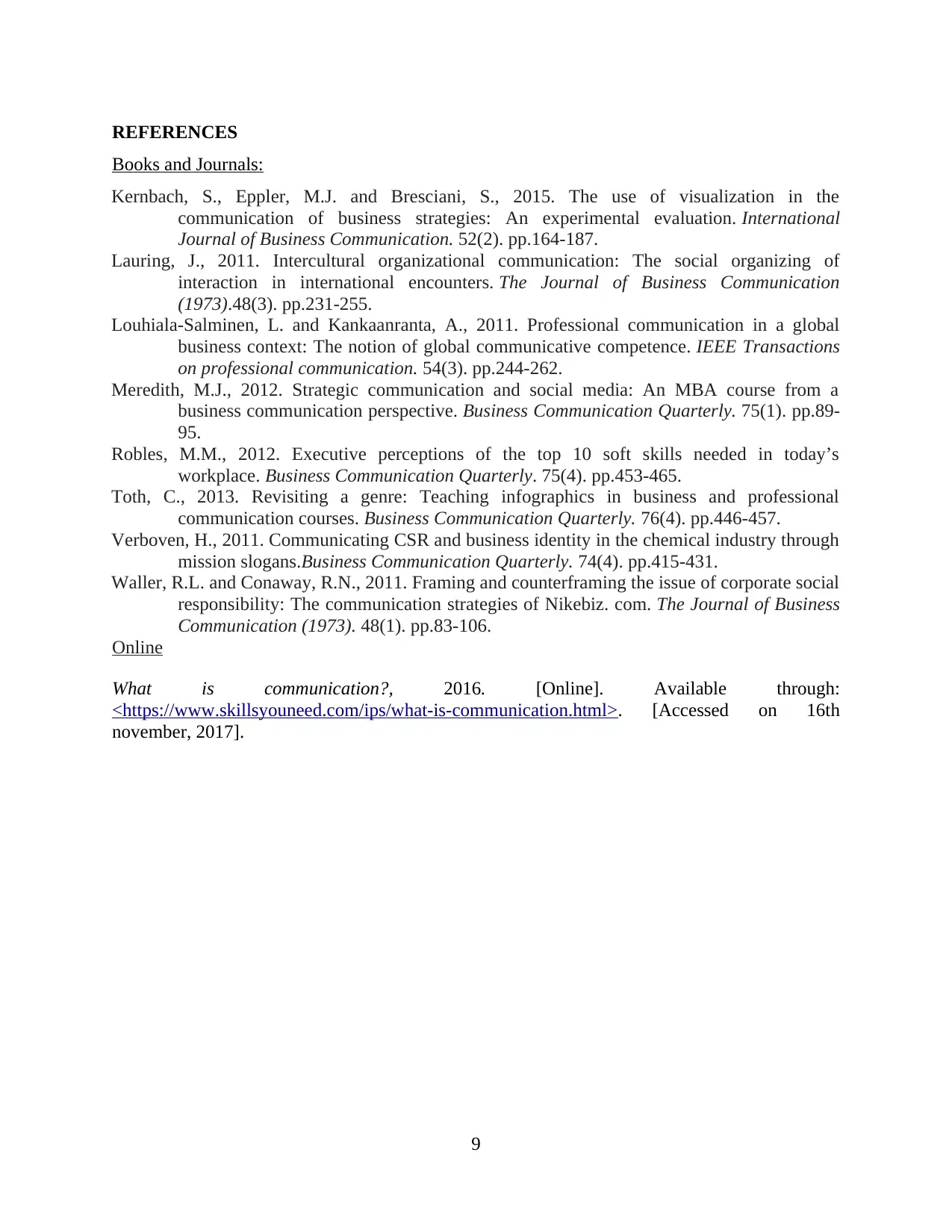
REFERENCES
Books and Journals:
Kernbach, S., Eppler, M.J. and Bresciani, S., 2015. The use of visualization in the
communication of business strategies: An experimental evaluation. International
Journal of Business Communication. 52(2). pp.164-187.
Lauring, J., 2011. Intercultural organizational communication: The social organizing of
interaction in international encounters. The Journal of Business Communication
(1973).48(3). pp.231-255.
Louhiala-Salminen, L. and Kankaanranta, A., 2011. Professional communication in a global
business context: The notion of global communicative competence. IEEE Transactions
on professional communication. 54(3). pp.244-262.
Meredith, M.J., 2012. Strategic communication and social media: An MBA course from a
business communication perspective. Business Communication Quarterly. 75(1). pp.89-
95.
Robles, M.M., 2012. Executive perceptions of the top 10 soft skills needed in today’s
workplace. Business Communication Quarterly. 75(4). pp.453-465.
Toth, C., 2013. Revisiting a genre: Teaching infographics in business and professional
communication courses. Business Communication Quarterly. 76(4). pp.446-457.
Verboven, H., 2011. Communicating CSR and business identity in the chemical industry through
mission slogans.Business Communication Quarterly. 74(4). pp.415-431.
Waller, R.L. and Conaway, R.N., 2011. Framing and counterframing the issue of corporate social
responsibility: The communication strategies of Nikebiz. com. The Journal of Business
Communication (1973). 48(1). pp.83-106.
Online
What is communication?, 2016. [Online]. Available through:
<https://www.skillsyouneed.com/ips/what-is-communication.html>. [Accessed on 16th
november, 2017].
9
Books and Journals:
Kernbach, S., Eppler, M.J. and Bresciani, S., 2015. The use of visualization in the
communication of business strategies: An experimental evaluation. International
Journal of Business Communication. 52(2). pp.164-187.
Lauring, J., 2011. Intercultural organizational communication: The social organizing of
interaction in international encounters. The Journal of Business Communication
(1973).48(3). pp.231-255.
Louhiala-Salminen, L. and Kankaanranta, A., 2011. Professional communication in a global
business context: The notion of global communicative competence. IEEE Transactions
on professional communication. 54(3). pp.244-262.
Meredith, M.J., 2012. Strategic communication and social media: An MBA course from a
business communication perspective. Business Communication Quarterly. 75(1). pp.89-
95.
Robles, M.M., 2012. Executive perceptions of the top 10 soft skills needed in today’s
workplace. Business Communication Quarterly. 75(4). pp.453-465.
Toth, C., 2013. Revisiting a genre: Teaching infographics in business and professional
communication courses. Business Communication Quarterly. 76(4). pp.446-457.
Verboven, H., 2011. Communicating CSR and business identity in the chemical industry through
mission slogans.Business Communication Quarterly. 74(4). pp.415-431.
Waller, R.L. and Conaway, R.N., 2011. Framing and counterframing the issue of corporate social
responsibility: The communication strategies of Nikebiz. com. The Journal of Business
Communication (1973). 48(1). pp.83-106.
Online
What is communication?, 2016. [Online]. Available through:
<https://www.skillsyouneed.com/ips/what-is-communication.html>. [Accessed on 16th
november, 2017].
9
1 out of 11
Related Documents
Your All-in-One AI-Powered Toolkit for Academic Success.
+13062052269
info@desklib.com
Available 24*7 on WhatsApp / Email
![[object Object]](/_next/static/media/star-bottom.7253800d.svg)
Unlock your academic potential
© 2024 | Zucol Services PVT LTD | All rights reserved.





